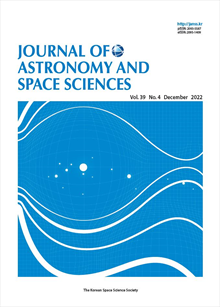간행물
Journal of Astronomy and Space Sciences KCI 등재 SCOPUS

- 발행기관 한국우주과학회
- 자료유형 학술지
- 간기 계간
- ISSN 2093-5587 (Print)2093-1409 (Online)
- 수록기간 1984 ~ 2022
- 주제분류 자연과학 > 천문학 자연과학 분류의 다른 간행물
- 십진분류KDC 443DDC 520
권호리스트/논문검색
제39권 3호 (2022년 9월) 5건
1.
2022.09
서비스 종료(열람 제한)
Thermospheric wind observations from high to mid latitudes are compared with the newly developed Multiscale Atmosphere Geospace Environment (MAGE) model for the Nov 3–4 geomagnetic storm. The observation and simulation comparison shows a very good agreement and is better at high latitudes in general. We were able to identify a thermospheric poleward wind reduction possibly linked to a northward turning of the Interplanetary Magnetic Field (IMF) at ~22 UT on Nov 3 and an enhancement of the poleward wind to a southward turning near 10 UT on Nov 4 at high latitudes. An IMF southward turning may have led to an enhancement of equatorward winds at Boulder, Colorado near midnight. Simultaneous occurrence of aurora may be associated with an IMF By turning negative. The MAGE model wind simulations are consistent with observations in these cases. The results show the model can be a very useful tool to further study the magnetosphere and ionosphere coupling on short time scales.
2.
2022.09
서비스 종료(열람 제한)
The Far-UltraViolet (FUV) imager onboard the Ionospheric Connection Explorer (ICON) spacecraft provides two-dimensional limb images of oxygen airglow in the nightside low-latitude ionosphere that are used to determine the oxygen ion density. As yet, no FUV limb imager has been used for climatological analyses of Equatorial Plasma Bubbles (EPBs). To examine the potential of ICON/FUV for this purpose, we statistically investigate small-scale (~180 km) fluctuations of oxygen ion density in its limb images. The seasonal-longitudinal variations of the fluctuation level reasonably conform to the EPB statistics in existing literature. To further validate the ICON/FUV data quality, we also inspect climatology of the ambient (unfiltered) nightside oxygen ion density. The ambient density exhibits (1) the well-known zonal wavenumber-4 signatures in the Equatorial Ionization Anomaly (EIA) and (2) off-equatorial enhancement above the Caribbean, both of which agree with previous studies. Merits of ICON/FUV observations over other conventional data sets are discussed in this paper. Furthermore, we suggest possible directions of future work, e.g., synergy between ICON/FUV and the Global-scale Observations of the Limb and Disk (GOLD) mission.
3.
2022.09
서비스 종료(열람 제한)
There are two models that explain the rotation curves of galaxies: dark matter, which gives the missing contribution to the gravitational potential of the standard theory of gravity, and modified theories of gravity, according to which the gravitational potential is created by ordinary visible mass. Both models have some disadvantages. The article offers a new look at the problem of galactic rotation curves. The author suggests that the moment of inertia creates an additional gravitational potential along with the mass. The numerical simulation carried out on the example of fourteen galaxies confirms the validity of such an assumption. This approach makes it possible to explain the constancy of gas velocities outside the galactic disk without involving the hypothesis of the existence of dark matter. At the same time, the proposed approach lacks the disadvantages of modified theories of gravity, where the gravitational potential is created only by the mass of visible matter.
4.
2022.09
서비스 종료(열람 제한)
The small-scale magnetospheric and ionospheric plasma experiment (SNIPE) is a mission initiated by the Korea Astronomy and Space Science Institute (KASI) in 2017 and comprises four 6U-sized nano-satellites (Korea Astronomy and Space Science Institute Satellite-1, KASISat-1) flying in formations. The main goal of the SNIPE mission is to investigate the space environment in low Earth orbit at 500-km. Because Iridium & GPS Board (IGB) is installed on the KASISat-1, a communication simulation is required to analyze the contact number and the duration. In this study, communication simulations between the Iridium satellite network and KASISat-1 are performed using STK Pro (System Tool Kit Pro Ver 11.2) from the AGI (Analytical Graphics, Inc.). The contact number and durations were analyzed by each orbit and date. The analysis shows that the average access number per day is 38.714 times, with an average of 2.533 times per orbit for a week. Furthermore, on average, the Iridium satellite communication is linked for 70.597 min daily. Moreover, 4.625 min is the average duration of an individual orbit.
5.
2022.09
서비스 종료(열람 제한)
Kwangsun Ryu, Seunguk Lee, Chang Ho Woo, Junchan Lee, Eunjin Jang, Jaemin Hwang, Jin-Kyu Kim, Wonho Cha, Dong-guk Kim, BonJu Koo, SeongOg Park, Dooyoung Choi, Cheong Rim Choi
The Ionospheric Anomaly Monitoring by Magnetometer And Plasma-probe (IAMMAP) is one of the scientific instruments for the Compact Advanced Satellite 500-3 (CAS 500-3) which is planned to be launched by Korean Space Launch Vehicle in 2024. The main scientific objective of IAMMAP is to understand the complicated correlation between the equatorial electro-jet (EEJ) and the equatorial ionization anomaly (EIA) which play important roles in the dynamics of the ionospheric plasma in the dayside equator region. IAMMAP consists of an impedance probe (IP) for precise plasma measurement and magnetometers for EEJ current estimation. The designated sun-synchronous orbit along the quasi-meridional plane makes the instrument suitable for studying the EIA and EEJ. The newly-devised IP is expected to obtain the electron density of the ionosphere with unprecedented precision by measuring the upper-hybrid frequency (fUHR) of the ionospheric plasma, which is not affected by the satellite geometry, the spacecraft potential, or contamination unlike conventional Langmuir probes. A set of temperaturetolerant precision fluxgate magnetometers, called Adaptive In-phase MAGnetometer, is employed also for studying the complicated current system in the ionosphere and magnetosphere, which is particularly related with the EEJ caused by the potential difference along the zonal direction.

